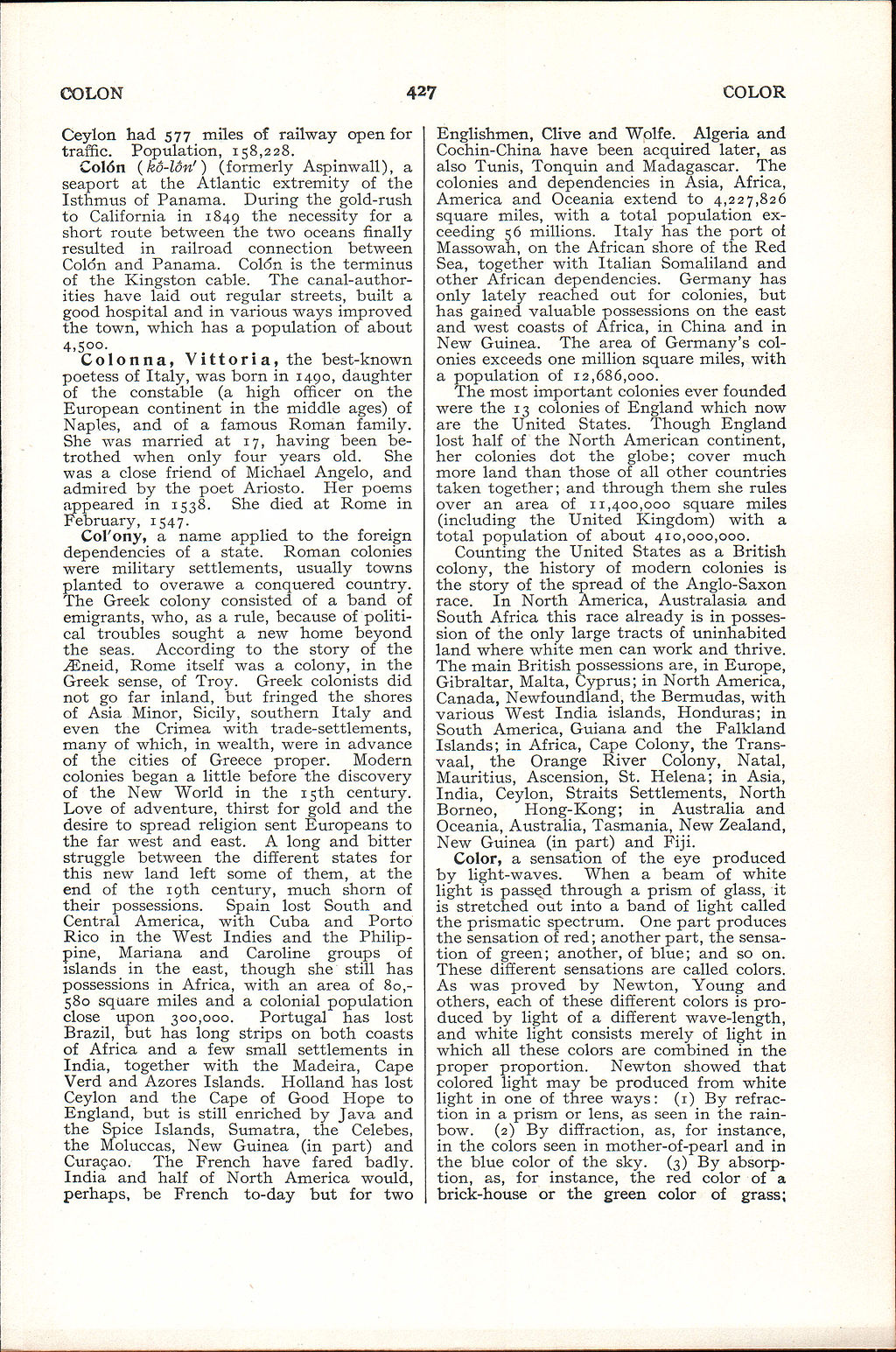COLON
427
COLOR
Ceylon had 577 miles of railway open for traffic. Population, 158,228.
Coldn (ko-lon'} (formerly Aspinwall), a seaport at the Atlantic extremity of the Isthmus of Panama. During the gold-rush to California in 1849 the necessity for a short route between the two oceans finally resulted in railroad connection between Colon and Panama. Colon is the terminus of the Kingston cable. The canal-authorities have laid out regular streets, built a good hospital and in various ways improved the town, which has a population of about 4,500.
Colonna, Vittoria, the best-known poetess of Italy, was born in 1490, daughter of the constable (a high officer on the European continent in the middle ages) of Naples, and of a famous Roman family. She was married at 17, having been betrothed when only four years old. She was a close friend of Michael Angelo, and admired by the poet Ariosto. Her poems appeared in 1538. She died at Rome in February, 1547.
Col'ony, a name applied to the foreign dependencies of a state. Roman colonies were military settlements, usually towns planted to overawe a conquered country. The Greek colony consisted of a band of emigrants, who, as a rule, because of political troubles sought a new home beyond the seas. According to the story of the ^neid, Rome itself was a colony, in the Greek sense, of Troy. Greek colonists did not go far inland, but fringed the shores of Asia Minor, Sicily, southern Italy and even the Crimea with trade-settlements, many of which, in wealth, were in advance of the cities of Greece proper. Modern colonies began a little before the discovery of the New World in the i5th century. Love of adventure, thirst for gold and the desire to spread religion sent Europeans to the far west and east. A long and bitter struggle between the different states for this new land left some of them, at the end of the i9th century, much shorn of their possessions. Spain lost South and Central America, with Cuba and Porto Rico in the West Indies and the Philippine, Mariana and Caroline groups of islands ^ in the east, though she still has possessions in Africa, with an area of 80,-580 square miles and a colonial population close upon 300,000. Portugal has lost Brazil, but has long strips on both coasts of Africa and a few small settlements in India, together with the Madeira, Cape Verd and Azores Islands. Holland has lost Ceylon and the Cape of Good Hope to England, but is still enriched by Java and the Spice Islands, Sumatra, the Celebes, the Moluccas, New Guinea (in part) and Curacao. The French have fared badly. India and half of North America would, perhaps, be French to-day but for two
Englishmen, Clive and Wolfe. Algeria and Cochin-China have been acquired later, as also Tunis, Tonquin and Madagascar. The colonies and dependencies in Asia, Africa, America and Oceania extend to 4,227,826 square miles, with a total population exceeding 56 millions. Italy has the port of Massowah, on the African shore of the Red Sea, together with Italian Somaliland and other African dependencies. Germany has only lately reached out for colonies, but has gained valuable possessions on the east and west coasts of Africa, in China and in New Guinea. The area of Germany's colonies exceeds one million square miles, with a population of 12,686,000.
The most important colonies ever founded were the 13 colonies of England which now are the United States. Though England lost half of the North American continent, her colonies dot the globe; cover much more land than those of all other countries taken together; and through them she rules over an area of 11,400,000 square miles (including the United Kingdom) with a total population of about 410,000,000.
Counting the United States as a British colony, the history of modern colonies is the story of the spread of the Anglo-Saxon race. In North America, Australasia and South Africa this race already is in possession of the only large tracts of uninhabited land where white men can work and thrive. The main British possessions are, in Europe, Gibraltar, Malta, Cyprus; in North America, Canada, Newfoundland, the Bermudas, with various West India islands, Honduras; in South America, Guiana and the Falkland Islands; in Africa, Cape Colony, the Transvaal, the Orange River Colony, Natal, Mauritius, Ascension, St. Helena; in Asia, India, Ceylon, Straits Settlements, North Borneo, Hong-Kong; in Australia and Oceania, Australia, Tasmania, New Zealand, New Guinea (in part) and Fiji.
Color, a sensation of the eye produced by light-waves. When a beam of white light is passed through a prism of glass, it is stretched out into a band of light called the prismatic spectrum. One part produces the sensation of red; another part, the sensation of green; another, of blue; and so on. These different sensations are called colors. As was proved by Newton, Young and others, each of these different colors is produced by light of a different wave-length, and white light consists merely of light in which all these colors are combined in the proper proportion. Newton showed that colored light may be produced from white light in one of three ways: (i) By refraction in a prism or lens, as seen in the rainbow. (2) By diffraction, as, for instance, in the colors seen in mother-of-pearl and in the blue color of the sky. (3) By absorption, as, for instance, the red color of a brick-house or the green color of grass;
